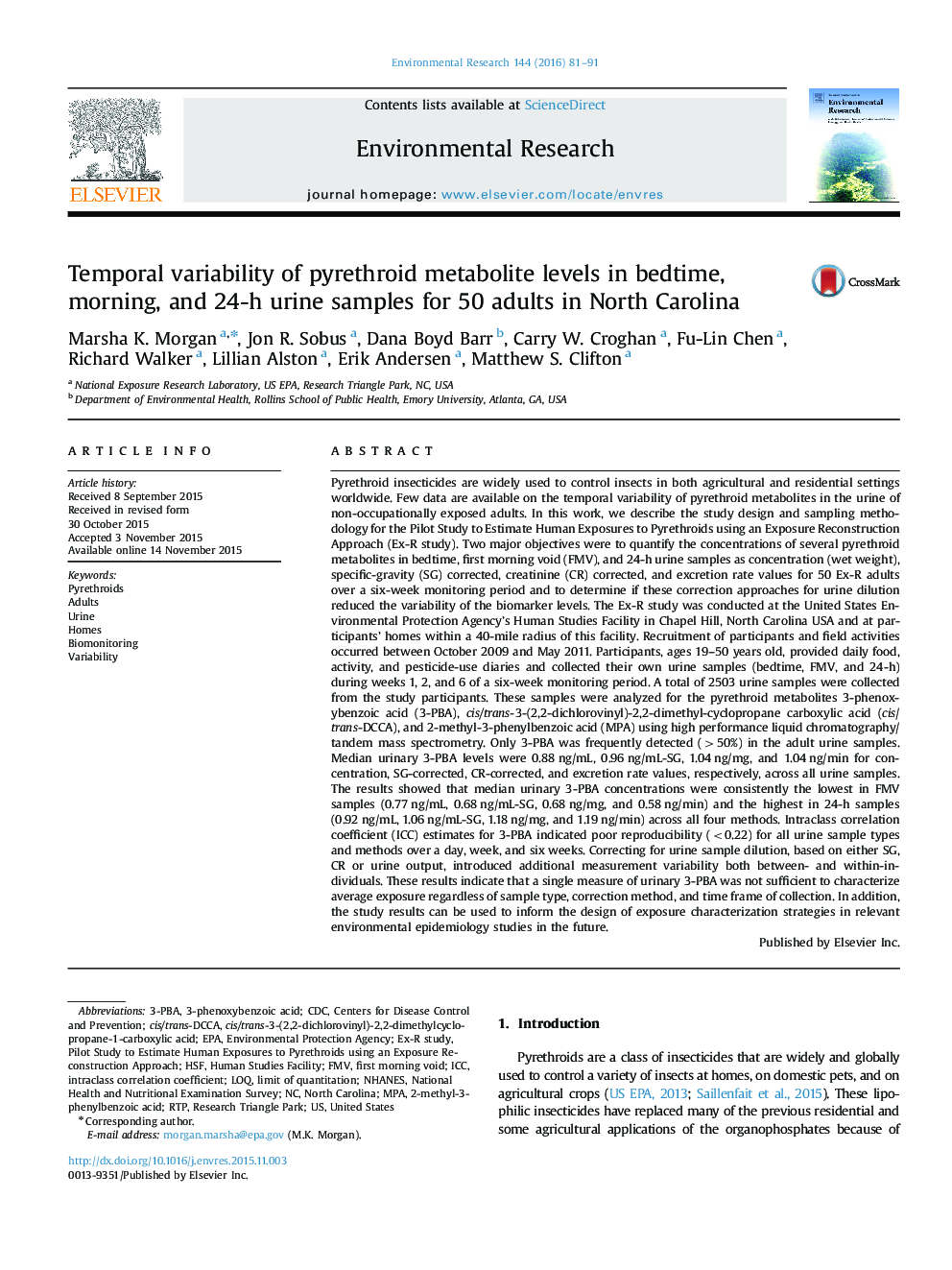| کد مقاله | کد نشریه | سال انتشار | مقاله انگلیسی | نسخه تمام متن |
|---|---|---|---|---|
| 4469652 | 1314296 | 2016 | 11 صفحه PDF | دانلود رایگان |
• Few data exist on the temporal variability of urinary pyrethroid metabolites in adults.
• 3-PBA was frequently detected (74%) in adult urine samples over a six-week period.
• ICCs indicated low reliability of repeated 3-PBA measurements in spot urine samples.
• Using correction methods to adjust for urine sample dilution increased measurement variability.
Pyrethroid insecticides are widely used to control insects in both agricultural and residential settings worldwide. Few data are available on the temporal variability of pyrethroid metabolites in the urine of non-occupationally exposed adults. In this work, we describe the study design and sampling methodology for the Pilot Study to Estimate Human Exposures to Pyrethroids using an Exposure Reconstruction Approach (Ex-R study). Two major objectives were to quantify the concentrations of several pyrethroid metabolites in bedtime, first morning void (FMV), and 24-h urine samples as concentration (wet weight), specific-gravity (SG) corrected, creatinine (CR) corrected, and excretion rate values for 50 Ex-R adults over a six-week monitoring period and to determine if these correction approaches for urine dilution reduced the variability of the biomarker levels. The Ex-R study was conducted at the United States Environmental Protection Agency’s Human Studies Facility in Chapel Hill, North Carolina USA and at participants’ homes within a 40-mile radius of this facility. Recruitment of participants and field activities occurred between October 2009 and May 2011. Participants, ages 19–50 years old, provided daily food, activity, and pesticide-use diaries and collected their own urine samples (bedtime, FMV, and 24-h) during weeks 1, 2, and 6 of a six-week monitoring period. A total of 2503 urine samples were collected from the study participants. These samples were analyzed for the pyrethroid metabolites 3-phenoxybenzoic acid (3-PBA), cis/trans-3-(2,2-dichlorovinyl)-2,2-dimethyl-cyclopropane carboxylic acid (cis/trans-DCCA), and 2-methyl-3-phenylbenzoic acid (MPA) using high performance liquid chromatography/tandem mass spectrometry. Only 3-PBA was frequently detected (>50%) in the adult urine samples. Median urinary 3-PBA levels were 0.88 ng/mL, 0.96 ng/mL-SG, 1.04 ng/mg, and 1.04 ng/min for concentration, SG-corrected, CR-corrected, and excretion rate values, respectively, across all urine samples. The results showed that median urinary 3-PBA concentrations were consistently the lowest in FMV samples (0.77 ng/mL, 0.68 ng/mL-SG, 0.68 ng/mg, and 0.58 ng/min) and the highest in 24-h samples (0.92 ng/mL, 1.06 ng/mL-SG, 1.18 ng/mg, and 1.19 ng/min) across all four methods. Intraclass correlation coefficient (ICC) estimates for 3-PBA indicated poor reproducibility (<0.22) for all urine sample types and methods over a day, week, and six weeks. Correcting for urine sample dilution, based on either SG, CR or urine output, introduced additional measurement variability both between- and within-individuals. These results indicate that a single measure of urinary 3-PBA was not sufficient to characterize average exposure regardless of sample type, correction method, and time frame of collection. In addition, the study results can be used to inform the design of exposure characterization strategies in relevant environmental epidemiology studies in the future.
Journal: Environmental Research - Volume 144, Part A, January 2016, Pages 81–91
